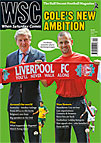 Just four months after facing West Germany in the World Cup final, a fiery defender arrived in Wiltshire. Graham Davidson remembers
Just four months after facing West Germany in the World Cup final, a fiery defender arrived in Wiltshire. Graham Davidson remembers
Before the Premier League era, what few foreigners there were in England often arrived after a World Cup. Nico Claesen came to Spurs in 1986, while Ricky Villa and Ossie Ardiles more famously arrived on the back of Argentina’s 1978 triumph. Italia 90 was the last tournament before overseas players became commonplace in the English game, and saw the aforementioned Ardiles, by then managing Swindon Town of the old Division Two, pull off a notable transfer coup in the shape of countryman Néstor Lorenzo.
Swindon’s association with Argentinean football began as far back as 1912, when an eight-game tour to the South American country prompted one local journalist to proclaim: “The arrival of the famous Swindon Town marks another era in the history of Association Football in the Argentine.” Another described the touring side as: “Undoubtedly one of the best teams in the world.”
The club’s link with Argentina was renewed a mere 77 years later, when Ardiles followed up a highly successful first season (securing promotion to Division One, only to be demoted weeks later as punishment for financial irregularities under a previous regime) by fighting off interest from Nottingham Forest in November 1990 to secure Lorenzo’s loan signature. The presence of an Argentine in the dugout meant Swindon fans left reeling from losing their top-flight status without kicking a ball could console themselves with the news that a recent World Cup finalist was coming to the County Ground.
First seen by the British public clearing off the line in the famous opening game defeat to Cameroon, Lorenzo appeared to both look and play like a typical South American centre-back. Boasting a highly impressive CV – beginning his career with Argentinos Juniors, followed by a season with Bari – Lorenzo eased into the Swindon team with a sublime defensive display in a 3-0 win over Portsmouth, capping the performance with a debut goal and a booking. Swindon fans took their new import to heart, with local radio phone-ins purring to the sound of “time on the ball”, and were further enthused when his loan from Italy was made permanent.
However, Lorenzo’s opening games would prove to be the peak of his career in England. Although he played a further 22 times, the club had clearly failed to recover from the off-field events of the previous year. Financial pressures forced the sale of playmaker Alan McLoughlin in December, and Ardiles himself departed for an ill-fated adventure at Newcastle soon after. New manager Glenn Hoddle could not initially halt the slide, with Swindon ending the season a single place clear of relegation.
Ardiles’ departure had removed Lorenzo’s very reason for coming to Wiltshire – it is inconceivable he would have chosen Swindon over top-flight Forest without the presence of his countryman – and Hoddle’s decision to bring in Shaun Taylor from Exeter to partner Colin Calderwood meant he soon fell out of favour. A World Cup finalist the previous year, Lorenzo had been dropped to accommodate someone who had still been playing non-League football aged 23.
With Hoddle himself operating as sweeper, Lorenzo was initially limited to a single substitute appearance in an opening-day win over Barnsley, but following an injury to the player-manager in October, it was widely assumed the Argentine would be an ideal replacement as a ball-playing defender. Lorenzo, though, would not play again until March. In Hoddle’s defence it is strongly rumoured that Swindon’s crippling financial condition may again have conspired against him. A significant part of Lorenzo’s £400,000 transfer fee was believed to be appearance based, suggesting Hoddle simply couldn’t afford to play him.
Although Lorenzo did eventually make a few final appearances for Swindon, notably coming on to rapturous applause at Oxford before being booked within minutes, his contract expired at the end of the season, and with a transfer back to Argentina with San Lorenzo his time in Wiltshire was over.
So what of Lorenzo’s career at the County Ground? A quick internet search reveals him to be chiefly remembered by opposing fans, notably Norwich and Leyton Orient, for his somewhat uncompromising approach to the art of defending. Swindon supporters, meanwhile, appear to be divided, with opinions ranging from “genuine international class’” to a nomination for worst-ever player. Although it is tempting to dismiss him as a player already in terminal decline by the time he arrived in England – he did not play for Argentina again following defeat in 1990 – a continued career in Argentina’s top league, including a spell at Boca Juniors, would suggest otherwise. Far more plausible is the suggestion that Lorenzo simply arrived at the wrong time, at a club who could neither afford nor accommodate him.
From WSC 283 September 2010